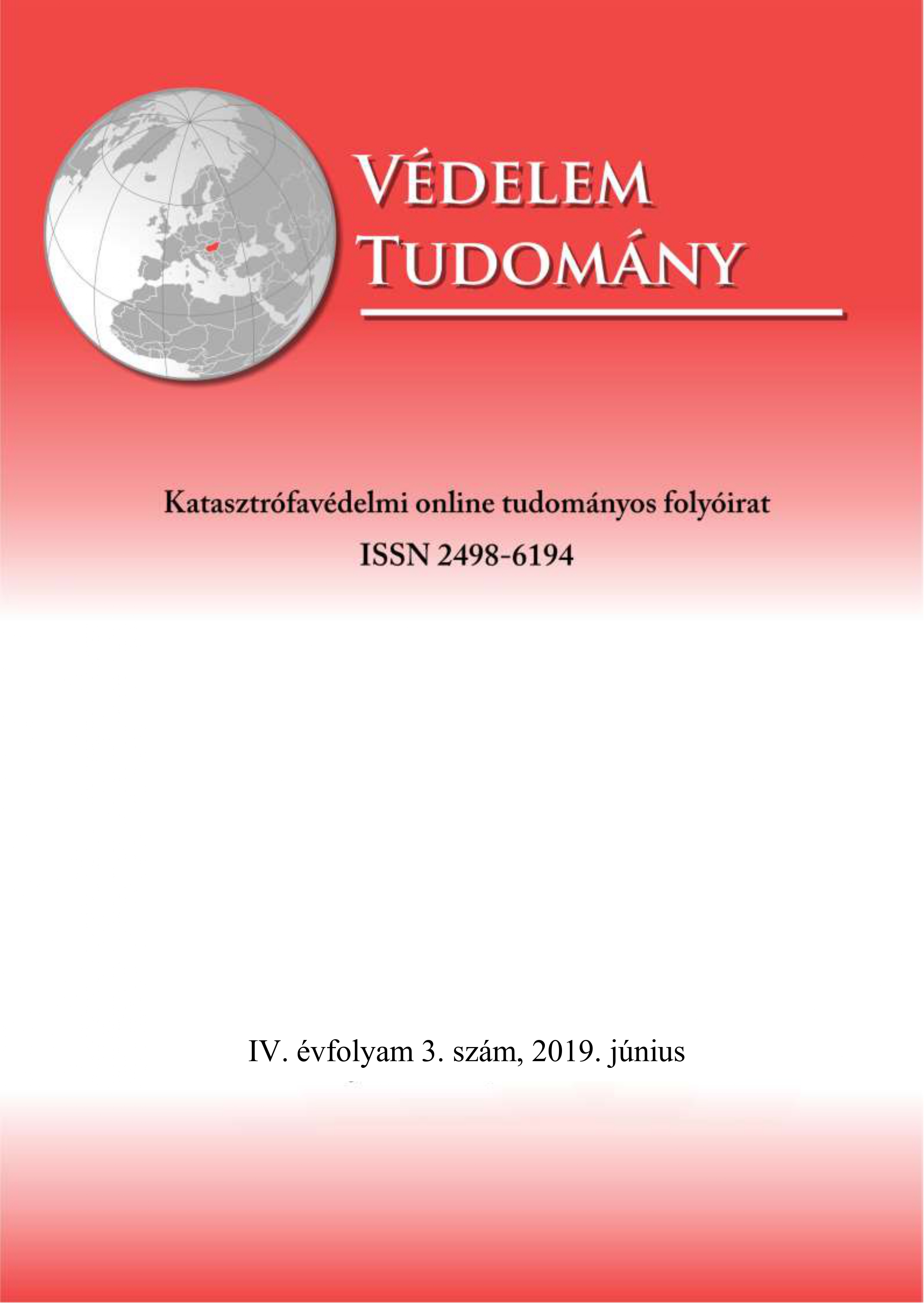Organization and implementation of evacuation drills
Abstract
Fire or other emergencies may justify evacuation of persons in building or open spaces. When evacuating, it is recommended the fastest way and with the least possible damage. Evacuation drills can greatly contribute to the training of the participants, so that, in event of a real emergency, they could leave the building or hazardous open space as quick as possible. Evacuation drills can be effective in training. For this to happen, it is necessary to properly plan,
organize and efficiently implement the drills. The author presents in this publication possible solutions to be considered when organizing and conducting evacuation drills.
References
Az 54/2014. (XII. 5.) BM rendelet az Országos Tűzvédelmi Szabályzatról
Az 1996. évi XXXI. törvény a tűz elleni védekezésről, a műszaki mentésről és a tűzoltóságról
A 30/1996. (XII. 6.) BM rendelet a tűzvédelmi szabályzat készítéséről
HERCZEG G., BÉRCZI L.: Közösségi rendeltetésű épületek kiürítési gyakorlatainak tapasztalatai. Védelem Tudomány, IV. 2. (2019) 84–103. o.
RESTÁS Á.: Tűzoltók szemtől szemben az érintettekkel: Viselkedésformák tűz- és káreseteknél; Bolyai Szemle XIII. 3. (2014) 25–35. o.
RESTÁS Á.: Pszichológia a tűz frontvonalában. Védelem Tudomány, I. 3. (2016) 46–56. o.
SCHÜLLER A.: Az emberi tényező és a technikai megvalósítások vizsgálata tűzriadók során. Hadmérnök VII. 2. (2012) 37–46. o.
RESTÁS Á.: A tűzoltásvezető döntéshozatali mechanizmusa. Védelem, VIII. 2. (2001) 28–30. o.
ZAHARI N. F., ALIMIN A. F., SUDIRMAN M. D., Mydin M. A. O.: A Study on Problems Arises in Practicing Fire Drill in High Rise Building in Kuala Lumpur. E3S Web of Conferences; 3. 01017. (2014)
Li Nian Feng, Zhiguo Xiao: A Fire Drill Training System Based on VR and Kinect Somatosensory Technologies. International Journal of Online and Biomedical Engineering (iJOE), 14. 4. (2018) pp. 163–176.
KOSHIBA, Y.; HAYASHIBARA, N.; SUZUKI, Y.; OHTANI, H.: Usefulness of fire drills in each university building. Kankyou to Anzen Tokyo, 3. 2. (2012) pp. 2–87.
CASTEL, A.D., VENDETTI, M., HOLYOAK, K.J.: Fire drill: Inattentional blindness and amnesia for the location of fire extinguishers. Atten Percept Psychophys 74. 7. (2012) pp. 1391–1396.
TAYLOR, A.; EDWARDS, R.: Fire Drill. RICS Building Surveying Journal, 2018. 2. (2018) pp.18–20.
SALMON, L.: Fire in the OR-Prevention and preparedness. AORN Journal, 80. 1. (2004) pp. 42–60.
GROAH, L. K; BUTLER, L. J.: Is there a relationship between workplace and patient safety? AORN Journal, 84. 4. (2006) pp. 653–654.
PEACOCK, R.; RENEKE, P.; KULIGOWSKI, E.; HAGWOOD, C.: Movement on Stairs During Building Evacuations. Fire Technology, 53. 2. (2017) pp. 845-871.
WADUD, Z., HUDA, F. Y., AHMED, N. U.: Assessment of Fire Risk in the Readymade Garment Industry in Dhaka, Bangladesh. Fire Technology, 50. (2014) pp. 1127–1154.
NFPA 101 Life Stafety Code. 2018 Edition https://www.nfpa.org/codes-andstandards/all-codes-and-tandards/list-of-codes-and-standards/detail?code=101 (letöltve 2019. 03. 01.)
CASTLE, N.G.: Nursing Home Evacuation Plans. American Journal of Public Health 98. 7. (2008) pp. 1235–1240
LEE, P.H. et al.: The effectiveness of an on-line training program for improving knowledge of fire prevention and evacuation of healthcare workers: A randomized controlled trial. PLOS ONE 13. 7. pp. 1–15.
TSUIL, S. C.; CHOW, W. K.: Legislation aspects of fire safety management in Hong Kong. Facilities, 22. 5/6. (2004) p. 156.
FAUZI, M. H.; IDROSE A. M.; ABDULLAH, A. H. A.; ZUL, J.; NORDIN, N. H. M.: The Pattern of Injuries or Medical Emergencies During High- Rise Evacuation Drill. Journal of Pioneering Medical Sciences, 4. 2. (2014) p. 82.
PROUL, G.: How to initiate evacuation movement in public buildings. Facilities, 17. 9/10. (1999) pp. 1–7.
BENTHORN, L.; FRANTZICH, H.: Fire Alarm in a Public Building: How Do People Evaluate Information and Choose Evacuation Exit? Report 3082, Department of Fire Safety Engineering, Lund University (1996) pp. 2–36.
ŠIMIĆ, Z.: Ponašanje ljudi u požaru. Sigurnost, 55. 1. (2013) pp. 45–51.
HASHEMI, M.: Emergency evacuation of people with disabilities: A survey of drills, simulations, and accessibility. Cogent Engineering, 2018. 5. (2018) pp. 1–20.
KOMJÁTHY L.: Műemlékek tűzvédelme – Tűzoltásra hangolva? Katasztrófavédelmi Szemle, XX. 3. (2013) 46–47. o.
BÉRCZI L., ECSETI B.: A beavatkozás biztonságának feltételei az M3-as metró területén. Védelem, XVIII. 5. (2011) 25–27. o.
TvMI 2.2:2016.12.20. Tűzvédelmi műszaki irányelv: Kiürítés (http://www.katasztrofavedelem.hu/letoltes/otsz/kiurites_TVMI_20161220.pdf, letöltve: 2018.12.03.)
BÉRCZI L.: Biztonságos tűzoltói beavatkozásokat elősegítő tűzvédelmi előírások tudományos megalapozása az M4-es metró szakaszán. Bolyai Szemle, XXIII. 3. (2014) 14–24. o.
A 9/2015. (III. 25.) BM rendelet a hivatásos katasztrófavédelmi szerveknél, az önkormányzati és létesítményi tűzoltóságoknál, az önkéntes tűzoltó egyesületeknél, valamint az ez irányú szakágazatokban foglalkoztatottak szakmai képesítési követelményeiről és szakmai képzéseiről
https://www.navy.mil/management/photodb/photos/081007-N-4044H-271.jpg (letöltve: 2019. 05. 10.)
VERESNÉ RAUSER J., KOVÁCS T.: Kórház kiürítés vizsgálata számítógépes kiürítés szimulációval. Védelem Tudomány, IV. 2. (2019) 27. o.




